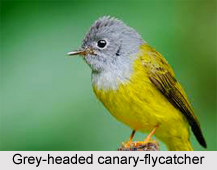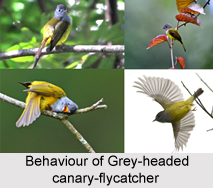 Grey-Headed Canary-Flycatcher sometimes known as the Grey-Headed Flycatcher is an Indian bird that bears a scientific name "Culicicapa ceylonensis" and belongs to the family of flycatcher, found in the forested parts of Central Indian states like Madhya Pradesh.
Grey-Headed Canary-Flycatcher sometimes known as the Grey-Headed Flycatcher is an Indian bird that bears a scientific name "Culicicapa ceylonensis" and belongs to the family of flycatcher, found in the forested parts of Central Indian states like Madhya Pradesh.
Concentration of Grey-Headed Canary-Flycatcher
Grey-Headed Canary-Flycatcher is a species of small flycatcher-like bird found in tropical Asia. It has a square crest, a grey hood and yellow under parts.
Habitats of Grey-Headed Canary-Flycatcher
Grey-Headed Canary-Flycatchers are found mainly in forested habitats where they often join other birds in mixed-species foraging flocks. Pairs are often seen as they forage for insects by making flycatcher-like sallies and calling aloud. Several subspecies are recognized within their wide distribution range. In the past the genus Culicicapa was considered to be an Old World flycatcher but studies have found them to belong to a new family designated as the Stenostiridae or fairy flycatchers that include the African genera Stenostira and Elminia.
Structure of Grey-Headed Canary-Flycatcher
Grey-Headed Canary-Flycatcher is about 12-13 cm long with a squarish grey head, a canary yellow belly and yellowish-green upperparts. They forage actively like flycatchers and perches in a very upright posture. The sexes are indistinguishable in plumage. They have a very flat bill (which gave it the earlier genus name of Platyrhynchus) which when seen from above look like an equilateral triangle and is fringed with long rictal bristles.
Population of Grey-Headed Canary-Flycatcher
The populations of Grey-Headed Canary-Flycatcher differ in the shades of the colours and vary slightly in dimensions and several of these have been designated as subspecies.
 Breeding Season of Grey-Headed Canary-Flycatcher
Breeding Season of Grey-Headed Canary-Flycatcher
Grey-Headed Canary-Flycatcher breeds in peninsular India in the hills of the Western Ghats Mountain Range in India, Nilgiris Mountain Range, Central Indian Forest Land and the Eastern Ghats Mountain Range in India and Sri Lanka.
Description of Grey-Headed Canary-Flycatcher
The Subspecies calochrysea of Grey-Headed Canary-Flycatcher was first described by Harry Oberholser in 1923 breeds along the Himalayas east to Myanmar and Thailand and winters across southern India. The nominate form is darker in shade. Subspecies antioxantha which was also described by Oberholser has a breeding range from southern Burma, Thailand through Malaysia to Java and Bali. The island forms of sejuncta described by Ernst Hartert in 1897 was found on Sumbawa, Flores and possibly on Lombok while connectens described by Bernhard Rensch in 1931 is restricted to the island of Sumba.
Grey-Headed Canary-Flycatcher in Mon Breeding Season
In the non-breeding season, Grey-Headed Canary-Flycatcher are seen in the plains and lower elevations (September to March in India) when they prefer well wooded areas of relatively mature secondary forests, abandoned plantations and overgrown gardens, usually near water and streams including wooded gorges. They are very active and noisy throughout the day foraging at all levels of the forest.
Feeding of Grey-Headed Canary-Flycatcher
Grey-Headed Canary-Flycatcher is an insectivore and like flycatchers makes sallies for aerial insects from a low perch under the canopy of a tree. A pair may forage together and they will often join mixed-species foraging flocks. They breed in summer (April to June) in India and possibly later in western China. The nest, built by the female alone, is an unlined cup bound by cobwebs and often attached to and covered by moss. The nest is found placed against the mossy trunk of a tree or built on rocks or on a ledge in a mud bank. The typical clutch is three or four eggs.



















